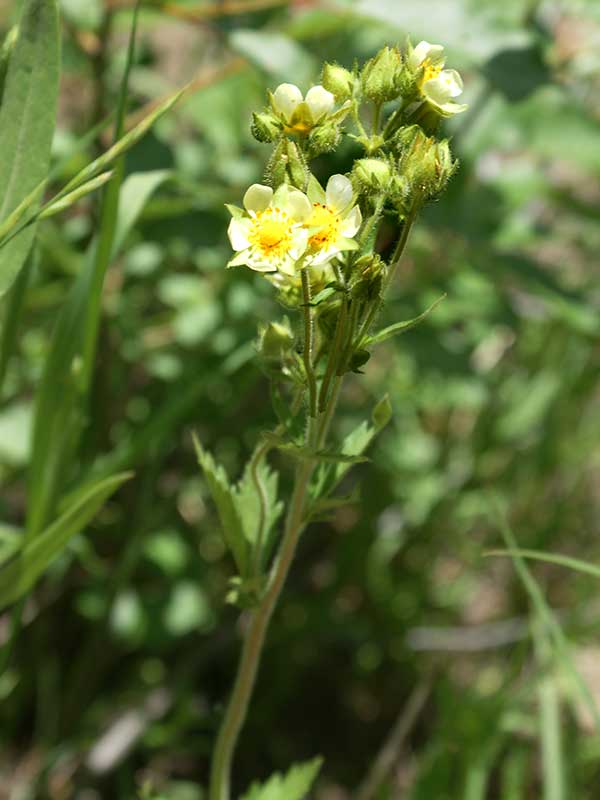Drymocallis arguta / tall cinquefoil
- yellow flowers, 5 petals with pointy green sepals between
- many stamens; central disk of yellow pistils
- flowers in clusters with short stems (cyme)
- most leaves basal – pinnately compound, coarsely toothed, obovate
- many soil types, but not overly moist
Also known as: prairie cinquefoil, sticky cinquefoil
Synonym: Potentilla arguta
See also: Drymocallis glandulosa / sticky cinquefoil
From the get go, the possible confusion of tall cinquefoil and “sticky” cinquefoil is clear because tall is also called sticky. I hope this writeup doesn’t make the confusion worse. At least these may be the only two Drymocallis species in the area. But then, they both used to be in the genus Potentilla, so …
Well anyway – tall cinquefoil is a perennial plant, up to 3 feet tall and unbranched, except slightly near the inflorescence. The entire plant looks light or whitish green.
Tall cinquefoil leaves are pinnately compound with an uneven number of leaflets, most commonly 7 to 11, i.e. slightly more than D. glandulosa. Overall, the leaves are up to 3 inches long and 2 inches across. The leaflets are obovate and coarsely serrated (toothed). Most of the leaves are in a basal rosette, but there are some smaller ones up higher, along the flowering stem. The leaves are covered, mostly on the bottom side, with short and somewhat sticky hairs (trichomes).
Tall cinquefoil flowers are arranged in a tight cluster (cyme) on a stem from ranging from 12-40 inches tall. They are strawberry-like (which just says they are in the Rosaceae) with five white or cream petals, generally a bit darker than those of sticky cinquefoil. Each flower has five pointed green sepals between the petals, and a ring of 20 or more stamens. There is a small golden structure full of pistils in the center. Nectar is secreted from a ring below the pistils. Each flower is ½ to ¾ inches across. Typically only a few flowers are open at a time.
After pollination, the seeds develop in a cup made up of the dried-up sepals. Basically, this cup looks a lot like a brown version of the flower buds before they open. It contains many small seeds. The old fruiting stems can persist through winter.
The root system has a taproot, but also rhizomes. These can give rise to tight clumps of plants, clones, but the plant is not particularly aggressive at spreading.
Tall cinquefoil is drought tolerant and not picky about soils as long as they are well drained. At home, should you want it, It thrives on neglect in sunny areas.
Interesting bits – Like other sticky plants (e.g. the sticky geranium), tall cinquefoil is suspected of being protocarnivorous, i.e. sort of prepared to be a carnivore but not there yet. Indeed, it looks like the removal of the Drymocallis spp. from the genus, Potentilla was based on this suspicion. One study showed that if a 14C labeled protein was applied to the leaves, there was some breakdown, possibly by enzymes exuded from the trichomes.
Under ultra-violet light, patterns are revealed in the flower petals that are thought to be bee guides, i.e. lines that direct bees and other pollinating insects to the stamens and pistils in the centers of the flowers. These are common in cinquefoils generally, but are widespread throughout the plant kingdom.
| Color | |
|---|---|
| Family | |
| Blossom size | |
| Inflorescence size | |
| Inflorescence type | |
| When? | |
| Where? |


